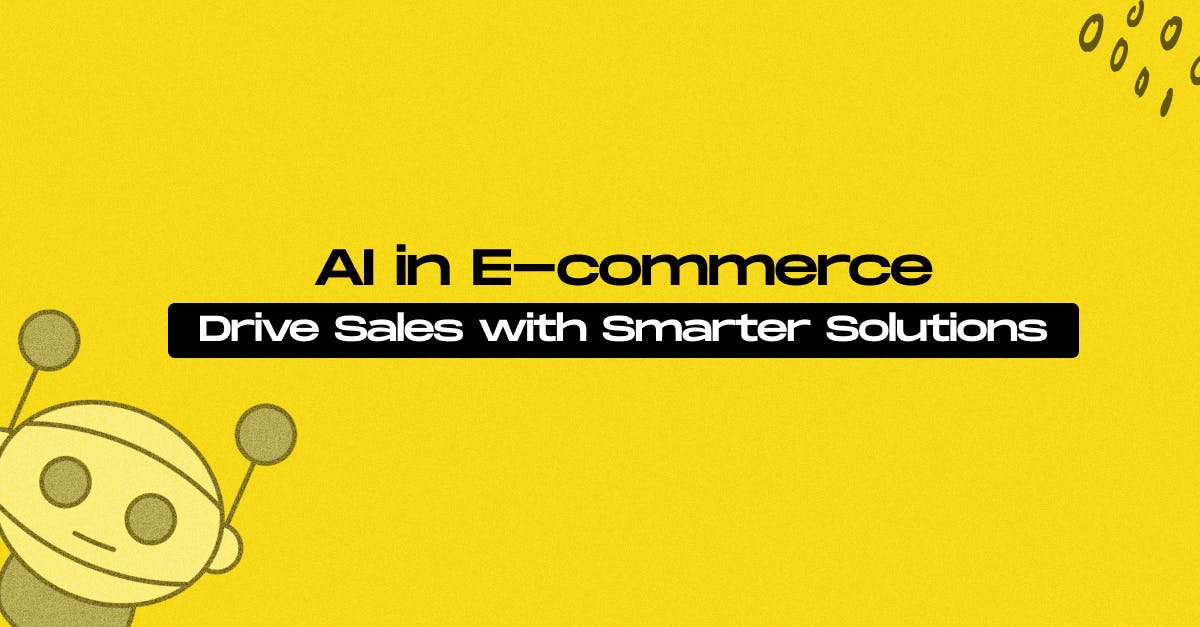April 16, 2025
How to Leverage AI in E-commerce for Success?

Nusrat Sarmin

AI in eCommerce isn’t just hype anymore, it’s a necessity; It has quietly become one of the most powerful tools behind some of the world’s fastest-growing online stores.
AI is changing how online stores operate, engage with customers, and grow. Whether you’re running a small shop or leading a fast-growing brand, AI has the power to simplify and strengthen your business process.
In this post, we’ll explore practical ways to implement AI in your eCommerce business—and boost both efficiency and growth.
“According to the IBM Global AI Adoption Index, 42% of large enterprises have actively deployed AI in their operations. An additional 40% are exploring or experimenting with AI technologies, highlighting a growing interest in integrating AI into business processes. Among these companies, 59% have accelerated their AI investments over the past 24 months, showing a strong commitment to gaining a competitive edge through AI.”
Why AI Matters in E-commerce?
Running an online store isn’t just about having great products anymore. It’s about timing. Relevance. Personalization. Today’s shoppers expect you to know them—what they like, what they’ve bought, what they might want next.
That’s where AI steps in.
With the right AI tools, your e-commerce business can:
- Understand what customers want—in real-time
- Automate the tedious stuff so your team can focus on growth
- Predict demand and set smarter prices
- Deliver personalized experiences at scale (without lifting a finger every time)
AI helps you rethink productivity. It's not about doing more work—it's about finding smarter ways to sell and scale with less effort.
✨ Already curious about how AI is transforming customer experience? Here’s our guide to AI in online shopping.
Advantages of AI in eCommerce Business
Here’s how AI is quietly changing the way modern stores operate and gaining a competitive edge:
👉 Hyper-Personalization: AI looks at customer behavior—what they click, browse, and buy—to recommend products that actually interest them. The result? Higher conversions and bigger cart sizes.
👉 Smarter Search: Visual and voice search powered by AI helps customers find exactly what they need—even if they can’t type it out perfectly.
👉 Predictive Power: AI doesn’t guess. It forecasts. From inventory needs to seasonal demand, it helps you plan your next move with confidence.
👉 Always-On Customer Support: With AI-powered chatbots, your store is never closed. Customers get help instantly, and your team doesn’t get burned out.
👉 Fraud Protection: AI can flag suspicious activity before it becomes a problem, helping keep both your business and your customers safe.
Let’s pause for a second. At StaticMania, we don’t just design beautiful websites—we integrate AI to elevate how brands sell online. From intelligent product recommendations to smart search and automation, we help implement the right tools, the right way. Let’s See
How to Leverage AI in E-commerce
The digital landscape is evolving fast, and technology is at the heart of many successful e-commerce businesses today. Here’s how you can use cutting-edge ai tools to boost your online store’s growth:
- Tailored Shopping Experiences:
Customers love shopping when the experience feels personal. Using tools like Dynamic Yield or Amazon Personalize, you can recommend products based on a customer’s browsing habits or past purchases. This creates a unique shopping journey and increases the chances of turning visitors into buyers. - Intelligent Customer Support with Chatbots:
Imagine having a support team that’s available 24/7 without the cost of extra staff. Chatbots, such as Tidio or ManyChat, help answer customer questions, recommend products, and guide them through the checkout process. By providing quick responses and assistance, they reduce cart abandonment and keep your customers happy. - Seamless Shopping with Visual Search:
Sometimes, customers don’t have the right words to describe what they want, but they do have an image. Visual search technology allows shoppers to upload pictures and find similar items in your store. This makes it easier for them to discover what they’re looking for, especially in fashion, furniture, or lifestyle products. - Automated Pricing Adjustments:
Staying competitive with your pricing is critical. Tools that monitor market trends and customer behavior can help adjust your prices automatically. This ensures that your prices remain attractive without needing manual updates, allowing you to optimize your sales strategy effortlessly. - Targeted Marketing with Customer Segmentation:
Rather than sending generic promotions, you can now tailor your marketing efforts to specific groups. By understanding your customers' preferences, buying habits, and locations, you can craft campaigns that are more likely to resonate with them and drive sales. - Optimizing Inventory Management:
Having the right products at the right time is crucial for smooth operations. By using forecasting tools, you can predict which products will be in demand, helping you avoid overstocking or running out of stock. This leads to a more efficient inventory process and better customer satisfaction.
How to Implement AI in Your E-commerce Business
You don’t have to dive in headfirst. Starting small and scaling as you see results is the smartest way to approach integrating AI into your e-commerce business. Here’s how you can get started:
Step 1: Identify the Problem: Where are you losing sales? Is it cart abandonment, low engagement, or poor customer service? Knowing the issue helps you pick the right AI solution.
Step 2: Set Clear Goals: Do you want to increase revenue, improve customer retention, or reduce workload? Define your success metrics from the start.
Step 3: Choose the Right Tools: Pick tools that fit your platform (like Shopify, WooCommerce, or custom solutions) and your use case. Consider both off-the-shelf tools and custom AI integration.
Step 4: Start Small and Test: Begin with one use case—like chatbots or recommendations—and monitor its impact. Make sure it integrates smoothly with your site.
Step 5: Optimize and Scale: Once you’ve seen the benefits, start scaling. Add more AI-driven features across your business and keep refining them. The more you test and optimize, the better the results.
Challenges of Implementing AI Technology in E-commerce
Implementing modern tools in e-commerce offers big potential—but not without a few key challenges.
1. Where Do You Start? There are endless tools. Product suggestions? Chat support? Price tweaks? Without a clear focus, it’s easy to go in circles.
2. It’s Not Always Cheap: Custom setups, new tools, and expert help all add up. For small businesses, that upfront cost can be a deal-breaker.
3. Integration Complexities: Connecting AI with your existing systems (like CMS or inventory) isn’t always smooth. Poor data flow or tool incompatibility can stall progress.
4. Data Accuracy and Privacy: AI relies on quality data. Incomplete or messy info leads to bad insights. Plus, privacy laws like GDPR can’t be ignored.
5. 5. Team Alignment: Tools alone won’t solve problems. Teams need training and clear direction to make the most of new solutions.
The good news? Every challenge has a solution—with the right partner by your side. At StaticMania, we help brands experiment with and integrate AI tools that fit their unique workflows. Let’s talk about your eCommerce Business.
Final Thoughts
The real value of AI in e-commerce isn’t just automation—it’s acceleration. It’s about giving your business the power to learn from every click, adapt to every trend, and grow at a speed traditional systems simply can’t match.
But here's the catch: AI is not a plug-and-play solution. To succeed, you need to:
- Start with clear goals (conversion, retention, AOV)
- Choose tools that integrate with your current stack
- Continuously optimize based on real-time insights
As the competition intensifies, those who embrace AI strategically will not only keep up—they’ll lead.
FAQ: How to Leverage AI in E-commerce for Success
AI in e-commerce refers to the use of artificial intelligence technologies—like machine learning, natural language processing, and predictive analytics—to automate, optimize, and personalize online shopping experiences.
AI enhances customer experience by providing personalized product recommendations, 24/7 support through chatbots, dynamic pricing, smart search, and tailored marketing messages—all of which improve user satisfaction and increase conversions.
Yes. By analyzing customer behavior, predicting trends, and offering personalized suggestions, AI drives higher engagement and boosts sales. AI-powered retargeting also helps recover abandoned carts and encourages repeat purchases.
- Personalized recommendations
- AI chatbots and virtual assistants
- Visual and voice search
- Inventory and supply chain optimization
- Dynamic pricing and demand forecasting
- Customer segmentation and behavior analysis
Not necessarily. Many affordable, scalable AI tools are now available through SaaS platforms. You can start small with AI chatbots or recommendation engines and expand as your business grows.
AI predicts demand based on seasonality, trends, and customer behavior. This helps optimize stock levels, reduce overstock or stockouts, and streamline logistics.
AI systems must follow strict data protection regulations like GDPR. When implemented properly with encryption and anonymization techniques, AI can securely handle customer data and even help detect fraud.
AI enables hyper-personalized email campaigns, smart segmentation, real-time customer insights, and automated ad targeting—making marketing more efficient and ROI-focused.
Not always. Many e-commerce platforms (like Shopify, BigCommerce, and WooCommerce) offer plug-and-play AI tools and integrations that require little to no coding. For advanced custom solutions, a developer may be helpful.
- Hyper-personalization at scale
- Voice and AR-powered shopping experiences
- Predictive customer lifetime value
- AI-driven content generation
- Automation across customer service, marketing, and logistics

